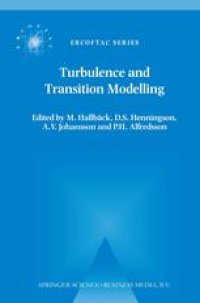
Ebook: Turbulence and Transition Modelling: Lecture Notes from the ERCOFTAC/IUTAM Summerschool held in Stockholm, 12–20 June, 1995
- Tags: Mechanics
- Series: ERCOFTAC Series 2
- Year: 1996
- Publisher: Springer Netherlands
- Edition: 1
- Language: English
- pdf
The aim of this book is to give, within a single volume, an introduction to the fields of turbulence modelling and transition-to-turbulence prediction, and to provide the physical background for today's modelling approaches in these problem areas as well as giving a flavour of advanced use of prediction methods. Turbulence modelling approaches, ranging from single-point models based on the eddy-viscosity concept and the Reynolds stress transport equations (Chapters 3,4,5), to large-eddy simulation (LES) techniques (Ch. 7), are covered. The foundations of hydrodynamical stability and transition are presented (Ch. 2) along with transition prediction methods based on single-point closures (Ch. 6), LES techniques (Ch. 7) and the parabolized stability equations (Ch. 8). The book addresses engineers and researchers, in industry or academia, who are entering into the fields of turbulence or transition modelling research or need to apply turbulence or transition prediction methods in their work.
The aim of this book is to give, within a single volume, an introduction to the fields of turbulence modelling and transition-to-turbulence prediction, and to provide the physical background for today's modelling approaches in these problem areas as well as giving a flavour of advanced use of prediction methods. Turbulence modelling approaches, ranging from single-point models based on the eddy-viscosity concept and the Reynolds stress transport equations (Chapters 3,4,5), to large-eddy simulation (LES) techniques (Ch. 7), are covered. The foundations of hydrodynamical stability and transition are presented (Ch. 2) along with transition prediction methods based on single-point closures (Ch. 6), LES techniques (Ch. 7) and the parabolized stability equations (Ch. 8). The book addresses engineers and researchers, in industry or academia, who are entering into the fields of turbulence or transition modelling research or need to apply turbulence or transition prediction methods in their work.
The aim of this book is to give, within a single volume, an introduction to the fields of turbulence modelling and transition-to-turbulence prediction, and to provide the physical background for today's modelling approaches in these problem areas as well as giving a flavour of advanced use of prediction methods. Turbulence modelling approaches, ranging from single-point models based on the eddy-viscosity concept and the Reynolds stress transport equations (Chapters 3,4,5), to large-eddy simulation (LES) techniques (Ch. 7), are covered. The foundations of hydrodynamical stability and transition are presented (Ch. 2) along with transition prediction methods based on single-point closures (Ch. 6), LES techniques (Ch. 7) and the parabolized stability equations (Ch. 8). The book addresses engineers and researchers, in industry or academia, who are entering into the fields of turbulence or transition modelling research or need to apply turbulence or transition prediction methods in their work.
Content:
Front Matter....Pages i-xi
Introduction....Pages 1-11
Stability and Transition of Boundary Layer Flows....Pages 13-80
The Basics of Turbulence Modelling....Pages 81-154
Constitutive Relations and Realizability of Single-Point Turbulence Closures....Pages 155-192
Advanced Turbulence Models for Industrial Applications....Pages 193-231
One-Point Closures Applied to Transition....Pages 233-268
Large-Eddy Simulations: Theory and Applications....Pages 269-336
Transition Modeling Based on the PSE....Pages 337-368
Back Matter....Pages 369-369
The aim of this book is to give, within a single volume, an introduction to the fields of turbulence modelling and transition-to-turbulence prediction, and to provide the physical background for today's modelling approaches in these problem areas as well as giving a flavour of advanced use of prediction methods. Turbulence modelling approaches, ranging from single-point models based on the eddy-viscosity concept and the Reynolds stress transport equations (Chapters 3,4,5), to large-eddy simulation (LES) techniques (Ch. 7), are covered. The foundations of hydrodynamical stability and transition are presented (Ch. 2) along with transition prediction methods based on single-point closures (Ch. 6), LES techniques (Ch. 7) and the parabolized stability equations (Ch. 8). The book addresses engineers and researchers, in industry or academia, who are entering into the fields of turbulence or transition modelling research or need to apply turbulence or transition prediction methods in their work.
Content:
Front Matter....Pages i-xi
Introduction....Pages 1-11
Stability and Transition of Boundary Layer Flows....Pages 13-80
The Basics of Turbulence Modelling....Pages 81-154
Constitutive Relations and Realizability of Single-Point Turbulence Closures....Pages 155-192
Advanced Turbulence Models for Industrial Applications....Pages 193-231
One-Point Closures Applied to Transition....Pages 233-268
Large-Eddy Simulations: Theory and Applications....Pages 269-336
Transition Modeling Based on the PSE....Pages 337-368
Back Matter....Pages 369-369
....